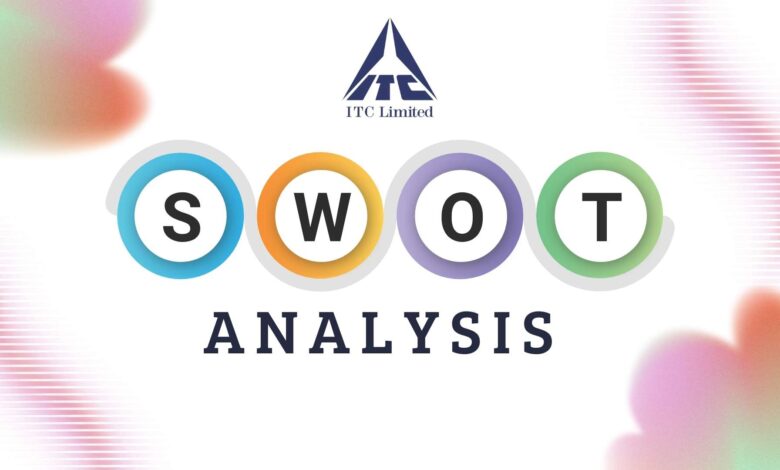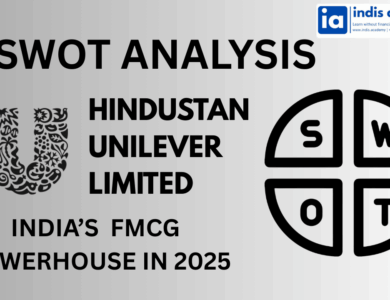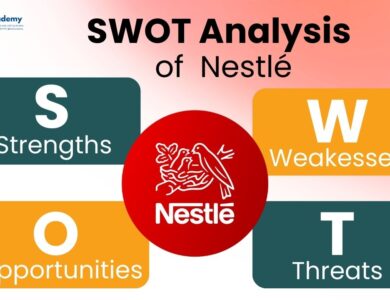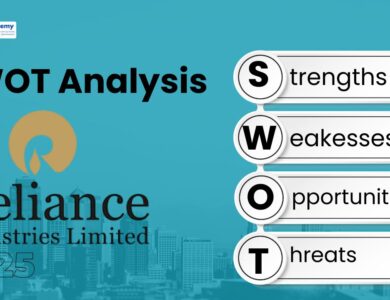SWOT Analysis of ITC (2025): Inside the Strategy of India’s Diversified FMCG Giant
Explore the detailed SWOT analysis of ITC in 2025. Discover the strengths, challenges, growth opportunities, and competitive threats shaping the future of one of India’s most diversified and profitable conglomerates.

When you think of Indian brands that touch your daily life—from the atta in your kitchen to the soap in your bathroom—chances are, you’re using something made by ITC.
From being once known solely for cigarettes, ITC has now transformed into a diversified FMCG powerhouse with strong interests in foods, personal care, agri-products, paper, hotels, and even IT services.
But in 2025, ITC stands at a critical juncture. On one hand, its non-cigarette businesses are growing rapidly. On the other, it still earns a major chunk of its profits from a sector that faces constant regulatory and ESG scrutiny.
So how is ITC positioned for the future?
This detailed SWOT analysis of ITC breaks down its Strengths, Weaknesses, Opportunities, and Threats—giving you a clear picture of where India’s most diversified conglomerate excels, where it lags, and how it’s shaping its next chapter.
Let’s begin with a quick snapshot of ITC as a company.
Also read: Complete SWOT Analysis of Uber: How It Dominates the Global Mobility Market
Learn AI & Digital Marketing,
Pay Fees After Placement
- ✅ Minimal Admission Fees
- ✅ No Loan or Income Sharing Agreement
- ✅ 100% Placement Support
- ✅ ISO & Govt Registered Certificate
- ✅ Practical 3+1 Months Duration
Get a free counseling call. We’ll guide you through learning, certification, and job placement.
Request a Free Call Back
Takes less than a minute.
Company Overview of ITC Limited
ITC Limited, founded in 1910 as the Imperial Tobacco Company of India, has evolved into one of India’s most respected and diversified business groups. Headquartered in Kolkata, ITC operates across five core segments:
-
FMCG (Foods, Personal Care, Agarbatti, and Stationery)
-
Cigarettes & Tobacco
-
Hotels
-
Paperboards & Packaging
-
Agri-Business
-
IT Services (via ITC Infotech)
As of 2025:
-
Market Cap: Over ₹5.5 lakh crore
-
Revenue (FY24–25): ₹75,000+ crore
-
Top Brands: Aashirvaad, Sunfeast, Bingo!, Fiama, Vivel, Savlon, Yippee!, Gold Flake, Classic
-
Employees: 36,000+
-
Recent Strategic Moves:
-
Hotel business demerger underway
-
Focus on asset-light expansion
-
Increasing stake in sustainable packaging and D2C channels
-
With deep rural penetration and a rapidly expanding FMCG portfolio, ITC is no longer just a cigarette company—it’s becoming India’s next-generation consumer goods giant.
What is a SWOT Analysis?
A SWOT analysis is a strategic tool used to assess a company’s position by evaluating four key areas:
-
Strengths – Internal advantages that help the company succeed
-
Weaknesses – Internal limitations that could hinder progress
-
Opportunities – External trends or openings the company can leverage
-
Threats – External risks or challenges that could impact performance
For a diversified conglomerate like ITC, a SWOT analysis is especially important. Unlike single-sector companies, ITC operates in multiple industries—from fast-moving consumer goods to luxury hotels to agri-export chains.
Understanding how its various arms complement—or complicate—each other is crucial to evaluating ITC’s strategy in 2025.
Also read: Complete SWOT Analysis of Uber: How It Dominates the Global Mobility Market
Strengths of ITC
ITC’s strength lies in its rare ability to operate profitably across diverse, unrelated sectors—a feat few Indian companies have managed at scale. From cigarettes to soaps, atta to artificial intelligence, ITC brings deep integration, efficient operations, and consumer trust.
Let’s break down what makes ITC so dominant in 2025:
1. Dominance in the Cigarette Segment
Despite diversification, ITC still holds over 75% market share in India’s cigarette industry, making it one of the company’s most profitable arms.
The segment, though controversial, funds innovation and expansion in other verticals, allowing ITC to invest heavily without external borrowing.
2. Growing FMCG Portfolio
Brands like Aashirvaad, Yippee!, Sunfeast, Bingo!, Fiama, Savlon, and Classmate have helped ITC become India’s third-largest FMCG company (non-cigarette).
Its foods division alone crossed ₹15,000 crore in revenue, driven by value, hygiene, and rural relevance.
3. Diversified Business Model
ITC is protected from sector-specific volatility because its revenues come from multiple verticals:
-
FMCG
-
Hotels
-
Agri-trade
-
Paperboards & packaging
-
IT services (via ITC Infotech)
This diversification acts as a natural hedge against economic downturns in any one sector.
4. In-House Agri Supply Chain
ITC sources directly from farmers through its e-Choupal and agri-commodity platforms, giving it control over raw material pricing, traceability, and quality.
This is a huge advantage in food processing, especially for staples and perishables.
5. Strong ESG & Sustainability Leadership
ITC is carbon positive, water positive, and solid waste recycling positive for over a decade—rare achievements in Indian corporate circles. This gives it a significant edge in ESG ratings, especially with global investors.
Competitor Comparison Table – 2025 Snapshot
| Company | FY25 Revenue (₹ Cr) | FMCG Share | Diversification | Key Brands | ESG Focus |
|---|---|---|---|---|---|
| ITC | 75,000+ | 28% | High (5 sectors) | Aashirvaad, Bingo, Fiama, Classic | Strong |
| Hindustan Unilever | 62,000+ | 100% | Low (pure FMCG) | Dove, Surf, Knorr, Lakmé | High |
| Nestlé India | 20,000+ | 100% | Low (FMCG only) | Maggi, Nescafé, KitKat, Milkmaid | Moderate |
| Dabur | 12,500+ | 100% | Moderate (healthcare, home) | Dabur, Real, Vatika | Good |
Data based on FY24–25 filings and public estimates.
ITC’s strengths are rooted in integration, legacy trust, and smart diversification—making it one of India’s most future-ready giants.
Weaknesses of ITC
While ITC’s diversification is its strength, it also presents challenges—especially when trying to match the agility of focused FMCG players or navigating regulatory roadblocks in tobacco and hospitality.
Let’s explore the internal limitations that may be holding ITC back in 2025:
1. Overdependence on Cigarettes for Profitability
Despite pushing into FMCG, over 40% of ITC’s operating profits still come from cigarettes. This dependence on a highly regulated and controversial sector raises ESG concerns and creates valuation pressure from global investors.
2. Slow-Moving Hotel Business
ITC Hotels, although prestigious, remains capital-intensive and slow to scale. It struggles with thin margins and high overhead costs—especially post-pandemic.
Even with the demerger underway, the hotel segment has long acted as a drag on consolidated performance.
3. Complex Corporate Structure
With multiple verticals operating under one umbrella, ITC is often perceived as a “conglomerate discount stock”—trading below its fair value due to complexity and lack of pure-play exposure.
This also makes internal capital allocation and strategic focus harder to manage.
4. Mid-Tier Brand Positioning in FMCG
While ITC has grown its FMCG portfolio rapidly, it still trails behind HUL and Nestlé in terms of premium branding and household penetration in personal care, beverages, and health foods.
Breaking into the top-tier urban segments is still a work in progress.
5. High Exposure to Regulatory Risks
Tobacco taxation, packaging laws, anti-smoking campaigns, and sustainability mandates all pose recurring threats to ITC’s core business. Frequent policy changes make long-term forecasting difficult.
To unlock its full value, ITC will need to sharpen focus, simplify structure, and speed up premium FMCG play—without losing its strength in scale.
Opportunities for ITC
ITC has built a rock-solid foundation—but the real upside lies in how it leverages scale, innovation, and brand equity to tap into India’s evolving consumption story.
Here are the key growth opportunities that ITC can capitalize on in 2025 and beyond:
1. Rapid Growth in Packaged & Health Foods
With rising demand for safe, branded staples and ready-to-eat meals, ITC’s food brands like Aashirvaad, Sunfeast, Bingo!, and Yippee! are gaining massive traction.
Expanding into health-focused and organic food categories can help ITC capture the health-conscious urban buyer.
2. Digital-First & D2C Expansion
Through platforms like ITC Store and presence on eCommerce channels, the company is moving towards direct-to-consumer models.
Launching digital-only brands, subscription packs, or premium SKUs online can offer higher margins and valuable customer insights.
3. Hotel Business Unlocking Value
ITC’s decision to demerge its hotel division into a separate listed entity could unlock shareholder value and reduce group complexity.
The hotel sector itself is recovering post-COVID, and an asset-light expansion strategy can make it profitable again.
4. Global Export Potential
ITC’s agri-exports, paperboards, and packaged foods (like noodles, snacks, and biscuits) have potential in Africa, Southeast Asia, and Middle East markets where Indian products are in high demand.
With the right branding and regulatory tie-ups, exports can become a major new growth driver.
5. Strategic Demergers or IPOs
Potential listing of ITC Infotech, or further demerging of verticals like FMCG and Paperboards, could help ITC unlock pure-play valuations—something that has been a long-standing demand from investors.
If ITC plays its cards right, it can evolve from a defensive value stock into a future-facing FMCG and agri-tech leader—with global presence and premium positioning.
Threats to ITC
Even a diversified powerhouse like ITC isn’t immune to market disruptions, consumer behavior shifts, and policy headwinds. As the competitive landscape tightens, ITC must navigate these external risks carefully.
Let’s explore the key threats ITC faces in 2025:
1. Regulatory Pressure on Cigarette Business
India has some of the strictest tobacco regulations in the world—from graphic packaging warnings to steep GST rates.
Further tightening could significantly impact volumes, margins, and brand visibility, threatening ITC’s most profitable vertical.
2. FMCG Competition from Startups and Giants
ITC faces pressure from every side—HUL, Nestlé, Dabur, and Britannia in premium categories, and Patanjali, Adani Wilmar, and Reliance Retail in price-led mass segments.
Add to that a wave of D2C startups (especially in health, beauty, and snacks), and ITC must fight for shelf space and attention.
3. Commodity Price Volatility
ITC’s input costs—wheat, oil, paper pulp, transportation, and packaging—are highly sensitive to global inflation trends.
Price hikes can squeeze margins or reduce competitiveness, especially in rural and low-ticket segments.
4. Conglomerate Discount and Complexity Risk
The more ITC grows across unrelated sectors, the more investors struggle to value it properly. The “conglomerate discount” could keep stock valuations suppressed unless further demergers or value-unlocking steps are taken.
5. Reputation Risk from ESG & Tobacco Debate
As ESG becomes central to global investing, ITC faces increasing scrutiny for earning billions from cigarettes—while expanding into wellness and personal care.
Balancing this contradiction without harming brand credibility or stakeholder trust will be crucial.
To stay ahead, ITC must remain agile, invest in premium and tech-driven growth, and clearly communicate its transformation roadmap.
Strategic Insights & Key Takeaways
ITC in 2025 stands as one of the most resilient and cash-rich Indian conglomerates—but it’s also at a point where perception and performance must align to unlock full value.
Here are the biggest takeaways from the SWOT analysis:
-
ITC’s core strengths—its scale, diversified model, strong brands, and supply chain integration—give it unmatched reach and stability.
-
But its overdependence on cigarettes and complex group structure continue to limit investor confidence and premium FMCG positioning.
-
The company has real momentum in foods, personal care, digital, and agri-exports—sectors that can define its next growth wave.
-
It must, however, move faster on value unlocking (via demergers/IPOs), ESG transparency, and brand innovation to stay competitive.
In short, ITC has the foundation to become India’s Procter & Gamble meets Philip Morris—if it plays smart and stays bold.
Conclusion
ITC is no longer just a cigarette company. It’s a complex, evolving enterprise that touches Indian lives through everything from biscuits and soaps to hotels, farm produce, and digital services.
In 2025, ITC’s biggest challenge isn’t growth—it’s narrative. While the company continues to expand and innovate across sectors, it must convince investors and consumers that it’s future-ready, not legacy-bound.
The SWOT analysis of ITC clearly shows it has the scale, resources, and momentum to lead—but success will depend on focus, speed, and storytelling as much as strategy.
FAQs – SWOT Analysis of ITC
1. Why is ITC called a diversified conglomerate?
Because it operates across multiple sectors—FMCG, cigarettes, hotels, paperboards, agri-trade, and IT services—offering risk-hedged, multi-stream revenue.
2. What is ITC’s biggest revenue driver?
Cigarettes remain the most profitable segment, though FMCG (non-cigarette) and agri-business are growing rapidly in revenue terms.
3. What are ITC’s top-performing FMCG brands?
Aashirvaad (atta), Yippee! (noodles), Sunfeast (biscuits), Bingo! (snacks), Savlon (hygiene), and Fiama (personal care).
4. Is ITC planning to demerge its businesses?
Yes, ITC has initiated the demerger of its hotel business and may explore further value unlocking through IPOs or spin-offs in ITC Infotech or FMCG in the future.





